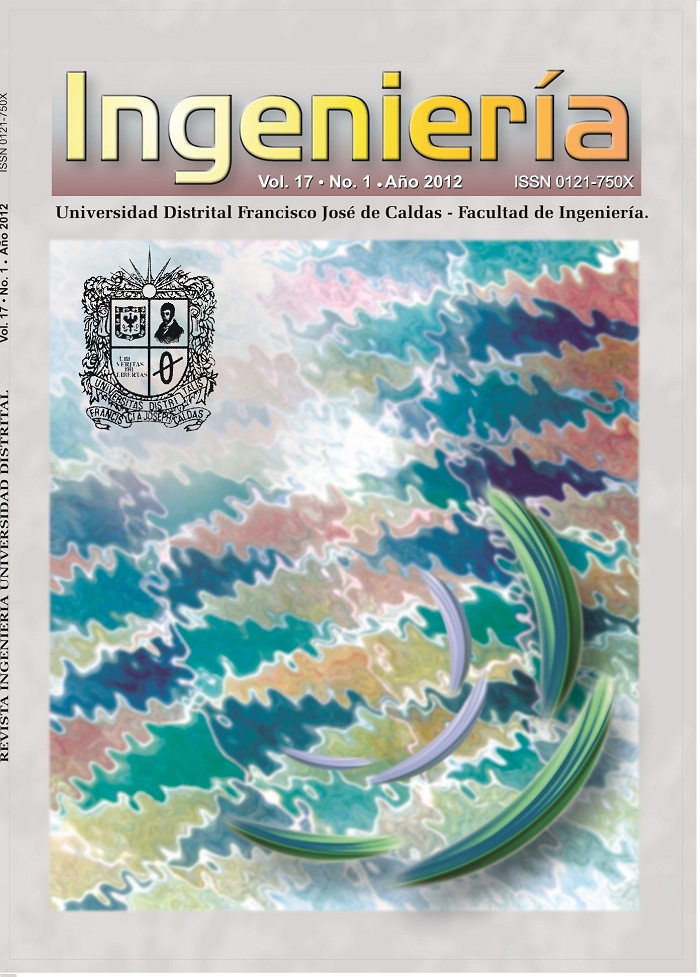DOI:
https://doi.org/10.14483/23448393.3847Published:
2012-06-29Issue:
Vol. 17 No. 1 (2012): January - JuneSection:
Special Section: Best Papers "VI Symposium on Optimization".Modelado y cálculo de parámetros de campos fotovoltaicos en condiciones climáticas irregulares
Modeling and parameter calculation of photovoltaic fields in irregular weather conditions
Keywords:
modeling, photovoltaic fields, mismatching. (en).Keywords:
modelado, campos fotovoltaicos, condiciones irregulares. (es).Downloads
Abstract (es)
Este artículo se presenta un modelo de campos fotovoltaicos (PV) y un procedimiento para calcular los parámetros de los módulos de una cadena fotovoltaica (grupo de módulos PV conectados en serie). El modelo propuesto considera las resistencias en serie y paralelo de los módulos, los diodos de bypass como interruptores ideales y aproxima los diodos de bloqueo con la ecuación de Shockley, permitiendo expresar el voltaje en función de la corriente (explícitamente) usando la función de Lambert-W; esto hace posible construir una ecuación por cada cadena para calcular su corriente en un voltaje dado. El procedimiento se repite para cada cadena y la corriente del campo se calcula sumando las corrientes de todas las cadenas. Para encontrar los parámetros se calcula el voltaje y la corriente de cada módulo activo a partir de la corriente y el voltaje de la cadena y luego se ajusta la ecuación de corriente de un módulo a los datos experimentales. La precisión del modelo fue probada experimentalmente con una cadena de dos módulos obteniendo una mejora cercana al 50 %.Abstract (en)
In this paper, a model for photovoltaic (PV) fields and a procedure for calculating the parameters of the modules of a string (a group of PV modules connected in series) are presented. The proposed model considers the series and parallel resistors of the photovoltaic modules, the bypass diodes as ideal switches and represents the blocking diodes with the Shockley equation, which allow to express the string voltage as an explicit function of the load current by using the LambertW function; in this way it is possible to construct one equation per string for calculating its current for a given voltage. That procedure is repeated for each string and the current of the field is evaluated by adding the currents of all strings. The parameter calculation procedure evaluates the voltage and current of each active module from the current and voltage of the string and fits the current equation of a module to the experimental data. The accuracy of the proposed model was tested experimentally with a string of two modules obtaining an accuracy improvement near to 50%.References
R. Faranda, S. Leva, and V. Maugeri, “MPPT techniques for PV Systems: Energetic and cost comparison”,2008 IEEE Power and Energy Society
General Meeting - Conversion and Delivery of Electrical Energy in the 21st Century, 2008, pp. 1-6.
IEA, “Technology Roadmap Solar photovoltaic energy”, 2010.
IEA, “Photovoltaic Power Systems Programme, Annual Report 2010”, 2010.
Giovanni Petrone, Giovanni Spagnuolo, and MasimoVitelli, “Analytical model of mismatched photovoltaic fields by means of Lambert W-
function”. Solar Energy Materials and Solar Cells, vol. 91, no. 18, Nov. 2007, pp. 1652-1657.
Giovanni Petrone and Carlos Ramos, “Modeling of photovoltaic fields in mismatched conditions for energy yield evaluations”. Electric Power
Systems Research, vol. 81, no. 4, Apr. 2011, pp. 1003-1013.
Hiren Patel and Vivek Agarwal, “MATLAB-Based Modeling to Study the Effects of Partial Shading on PV Array Characteristics”. Energy
Conversion, IEEE Transactions on, vol. 23, no. 1, Mar. 2008, pp. 302-310.
H. Tsai,C. Tu and Y. Su, “Development of generalized photovoltaic model using MATLAB/SIMULINK”,Proceedings of the World Congress on
Engineering and Computer Science 2008, 2008, pp. 1-6.
Marcelo Villalva, Jonas Gazoli, and Ernesto Filho, “Comprehensive Approach to Modeling and Simulation of Photovoltaic Arrays”. IEEE
Transactions on Power Electronics, vol. 24, no. 5, May 2009, pp. 1198-1208.
Daniel Chan and Jacob Phang, “Analytical methods for the extraction of solar-cell single- and double-diode model parameters from I-V
characteristics”. IEEE Transactions on Electron Devices, vol. 34, no. 2, Feb. 1987, pp. 286-293.
R. Corless, G. Gonnet, D. Hare, D. Jeffrey, and D. Knuth, “On the Lambert W function”. Advances in Computational Mathematics, vol. 5, no. 1,
Dec. 1996, pp. 329-359.
W. Desoto, S. Klein, and W. Beckman, “Improvement and validation of a model for photovoltaic array performance”. Solar Energy, vol. 80, no.1, Jan. 2006, pp. 78-88.
J.D. Bastidas, C. A. Ramos-Paja, G. Spagnuolo andG. Petrone, “Modeling of photovoltaic fields in mismatching conditions by means of
inflection voltages”, 2012 Workshop on Engineering Applications (WEA), 2012, pp. 1-6.
Ramaprabha Ramabadran and Badrilal Mathur, “Matlab based modeling and performance study of series connected SPVA under partial
shaded conditions”. Journal of Sustainable Development, vol. 2, no. 3, Nov 2009, pp. 85-94.
ERDM, “Datasheet ERDM 75-85 W.” Available in: http://www.erdmsolar.com/shop/images/stories/file/SM580.pdf.
How to Cite
APA
ACM
ACS
ABNT
Chicago
Harvard
IEEE
MLA
Turabian
Vancouver
Download Citation
License
From the edition of the V23N3 of year 2018 forward, the Creative Commons License "Attribution-Non-Commercial - No Derivative Works " is changed to the following:
Attribution - Non-Commercial - Share the same: this license allows others to distribute, remix, retouch, and create from your work in a non-commercial way, as long as they give you credit and license their new creations under the same conditions.




2.jpg)











